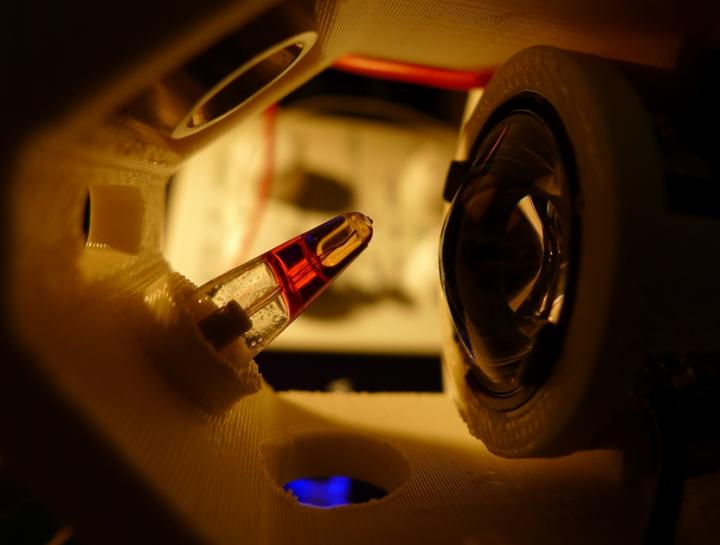New York, NY–October 1, 2020–A promising new COVID-19 rapid-testing technology platform developed by Rover Diagnostics and Columbia Engineering has been selected by the National Institutes of Health (NIH) to enter Phase 1 of the Rapid Acceleration of Diagnostics (RADx) initiative to support new COVID-19 testing technologies. The affordable, portable, and ultrafast point-of-care Rover platform provides reverse transcription polymerase chain reaction (RT-PCR) results in eight minutes, faster than any other test of its kind, with targeted accuracy to match laboratory-based tests.
Widely used since the 1980s for both clinical and research purposes, RT-PCR has been the gold standard for molecular diagnostic testing for decades. But because traditional PCR requires typically 45 minutes and trained technicians to operate the equipment, practical clinical use of the technology has mostly been in large, centralized labs. Because Rover’s PCR is very portable (about two pounds) and can be used by anyone, it will be targeted to locations where rapid turnaround results are important: for example, at pharmacies, transportation hubs, public events, and at companies screening employees coming back to work.
The platform was developed by Rover Diagnostics, a biotech start-up co-founded in 2018 by Biomedical Engineering Professor Sam Sia and serial tech entrepreneur Mark Fasciano, Rover’s CEO. The system uses sample preparation techniques developed at Sia’s lab, combined with a new approach to thermal cycling, bypassing the standard approach of Peltier device–a semiconductor that heats and cools the sample from outside the vial with radiant heat. Instead, Rover’s system uses a photothermal process that relies on nanoparticles to generate heat from inside.
“We were determined to develop a testing platform for all kinds of viruses that is cheap, reliable, and accessible to everyone,” says Sia, an innovator in point-of-care blood tests, wearable sensors, and implantable devices. “With Rover, we can now perform thermal cycling, which is the backbone of high-performing DNA and RNA testing, several times faster.”
The timing for Sia and Fasciano was fortuitous; Rover’s first prototype was completed just months before COVID-19 hit. The team quickly focused the Rover platform on the novel coronavirus and set the requirements to design as inexpensive and fast a COVID-19 test as possible.
“Prior to COVID, our mission to advance testing of infectious diseases was important, but the pandemic has intensified our efforts tenfold,” says Fasciano, a computer scientist-turned software and biotech entrepreneur. “Our rapid progress towards fast, cheap, ubiquitous testing has been possible largely through the unprecedented level of collaboration between Columbia Engineering and Rover, and the 24/7 dedication of our teams.”
In addition to COVID-19, Rover’s platform is designed to test for a broad range of infectious diseases including flu, strep, and other viruses that require fast diagnosis. Its targeted sensitivity is higher than other types of tests such as isothermal, antigen, and CRISPR. And is slated to be much faster than any other PCR test.
Sia and Fasciano now have a month to validate their platform. NIH launched the RADx initiative on April 29, 2020, just days after receiving an emergency supplemental appropriation of $1.5 billion from Congress. One arm of the RADx initiative supports innovative technologies that would make millions of rapid COVID-19 tests per week available to Americans by the fall. The call from NIH has received more than 700 applications.
More than 120 of the best concepts, including Rover’s, were selected to enter an intense one-week “shark-tank” technology evaluation process. The Rover team is among the 33 companies that have so far made the cut and advance to Phase 1, a rigorous four-week period of initial technology validation for scale up, manufacturing, and delivery to the marketplace.
The Rover team is optimistic about continuing the pace of progress. Says Sia, “We are expanding our testing of clinical samples and bringing together additional resources and expertise to finalize the design and speed to manufacturing. The NIH RADx initiative is accelerating our progress to bring the fast PCR platform to the widest possible good.”
This project is supported by the NIH Rapid Acceleration of Diagnostics (RADx) Tech program and has been funded in whole or in part with Federal funds from the National Heart, Lung and Blood Institute, National Institute of Biomedical Imaging and Bioengineering, National Institutes of Health, Department of Health and Human Services, under Grant No. U54HL143541.
###
LINKS:
http://engineering.
https:/
http://roverdx.
https:/
https:/
https:/
Columbia Engineering
Columbia Engineering, based in New York City, is one of the top engineering schools in the U.S. and one of the oldest in the nation. Also known as The Fu Foundation School of Engineering and Applied Science, the School expands knowledge and advances technology through the pioneering research of its more than 220 faculty, while educating undergraduate and graduate students in a collaborative environment to become leaders informed by a firm foundation in engineering. The School’s faculty are at the center of the University’s cross-disciplinary research, contributing to the Data Science Institute, Earth Institute, Zuckerman Mind Brain Behavior Institute, Precision Medicine Initiative, and the Columbia Nano Initiative. Guided by its strategic vision, “Columbia Engineering for Humanity,” the School aims to translate ideas into innovations that foster a sustainable, healthy, secure, connected, and creative humanity.
Rover Diagnostics
Rover Diagnostics was founded in 2018 by Samuel Sia and Mark Fasciano in collaboration with Columbia University. Based in New York City, Rover’s primary mission is to help meet the urgent global need for a cost-effective, highly sensitive, mass-produced point-of-care COVID-19 instrument and test kit system.









































